Clayton Kershaw dominated the rival Giants last season, going 5-0 with a 1.07 ERA and a 49:8 strikeout-to-walk ratio in six starts and 42 innings, including a perfect four-for-four in head-to-head battles with San Francisco ace Tim Lincecum. Kershaw has held the Giants to a sub-2.00 ERA again in 2012, though he had come up on the short end of the decision in two of his three starts against them to Monday's match-up with Madison Bumgarner. It was the first meeting for two young southpaws who will likely be dueling out west for years to come.
The numbers for the two pitchers are remarkably similar this season (see table), with Kershaw continuing to make his own case against DIPS theory by leading the NL in hit rate for the third time in four seasons, playing in front of a Dodger defense that ranks eighth in the majors in Defensive Efficiency. The L.A. ace has maintained a sub-.280 BABIP in each of the last three seasons, and his current mark of .268 would qualify as a career-best. Bumgarner entered the season with a career BABIP over .300, but his 2012 mark is even lower than Kershaw's in spite of the ninth-ranked gloves of the Giants.
2012 Stats (entering Monday's Game)
|
|
K/9 |
BB/9 |
H/9 |
|||||
|
Clayton Kershaw |
170.2 |
8.7 |
2.2 |
6.9 |
.268 |
2.90 |
1.01 |
11 – 6 |
|
Madison Bumgarner |
163.2 |
8.2 |
1.8 |
7.4 |
.262 |
2.97 |
1.01 |
13 – 7 |
The Duel
This was an intriguing matchup of two left-handers with widely disparate processes yet strikingly similar results. Kershaw has the electric stuff, pumping mid-90s gas when he's not causing heads to spin with his ferocious breaking pitches, but his mechanical profile is full of warts. On the other hand, Bumgarner relies on killer mechanical efficiency and deception to allow his more modest stuff to play up on the big stage. Both lineups were stacked to exploit the platoon advantage, with each team starting seven right-handed hitters to counter the southpaws on the mound. Kershaw and Bumgarner posted identical lines in the true outcome categories, with each lefty notching 10 strikeouts over eight full frames without issuing a single walk or home run. The Giants would scratch out two runs off of Kershaw, with both RBI coming courtesy of Pablo Sandoval, but the Dodgers were unable to score against Bumgarner.
Kershaw
|
Pitch Type |
Avg Speed |
Max Speed |
Avg H-Break |
Avg V-Break |
Count |
Strikes / % |
Whiffs / % |
SNIPs / % |
Linear Weights |
|
FF (FourSeam Fastball) |
93.54 |
95.6 |
0.01 |
12.90 |
61 |
43 / 70.49% |
5 / 8.20% |
33 / 64.71% |
-2.4685 |
|
CH (Changeup) |
84.10 |
84.1 |
6.93 |
13.23 |
1 |
1 / 100.00% |
0 / 0.00% |
1 / 100.00% |
-0.0672 |
|
SL (Slider) |
85.02 |
87.7 |
-4.35 |
3.67 |
30 |
26 / 86.67% |
9 / 30.00% |
20 / 83.33% |
0.1264 |
|
CU (Curveball) |
74.46 |
76.1 |
-3.68 |
-7.18 |
17 |
11 / 64.71% |
2 / 11.76% |
8 / 57.14% |
-1.06 |
|
Pitch classifications provided by the Gameday Algorithm. |
|||||||||
Kershaw has ideal velocity spreads for his three pitch types, a fact that helps to cover for his lack of a reliable change-up. The fastball ran 92-95 mph on Monday and was complemented by an 83-88 mph slider and a curve clocked from 72-76 mph. The slider is a knee-buckler with vicious snap and late break, forcing hitters to make a premature decision and coaxing ugly swings by the truck-load. Most impressive was Kershaw's command of his arsenal, from painting corners with his fastball to directing the tilt on his breaking pitches. He was nailing targets on both sides of the plate with his breaking stuff as well as his heat, demonstrating unreal command with incredible movement. The steep curve and the sharp slider are good enough to survive on movement alone, but Kershaw's ability to spot the pitches while mixing in high-speed lasers puts batters on the defensive in every at-bat. It is scary to think of how good he could be if he developed a trustworthy change-up.
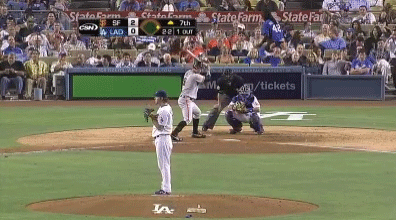
Kershaw went fastball heavy the first time through the lineup, ordering first-pitch heat to seven of the nine batters. He went to the breaking stuff as he got deeper in the count, though he registered just a single K on his first turn through the starting nine. Kersh featured the weapons-grade slider more as the game wore on, and the helplessness of the Giants' batters was reflected in the numbers, as the southpaw threw more than half of his sliders in the sixth through eighth innings while recording seven of his 10 strikeouts in the process. Kershaw's slider had the highest whiff percentage, but eight of his strikeouts were sealed by fastballs and curves, as the slider was used to keep Kershaw ahead while he advanced the count. Kershaw threw harder as he went deeper into the game, with velocity that peaked at 95 mph in the sixth inning and was offset by a killer curveball that left batters scratching their heads.

Key AB: Pablo Sandoval, top of the sixth inning.
Sandoval had driven in the only run of the game when he strode to the plate with two out, two men on, and a chance to add to his RBI total. Kershaw started the Panda with a 95-mph fastball that missed the zone up and in, but Sandoval did the Dodgers a favor by hacking at the pitch for strike one. Kersh went back to the well on 0-1, but Sandoval heeded the lesson and took the pitch to even the count. He went for the heat a third time as A.J. Ellis set up down and in, but Kershaw missed his target with another elevated fastball that Sandoval dumped into short left field for a single, scoring Angel Pagan on a close play at the plate and doubling LA’s deficit. Kershaw may have been lucky to avoid worse damage, as throwing three consecutive pitches at the same velocity and location is a recipe for disaster against a hitter of Panda's skill.
Bumgarner
|
Pitch Type |
Avg Speed |
Max Speed |
Avg H-Break |
Avg V-Break |
Count |
Strikes / % |
Whiffs / % |
SNIPs / % |
Linear Weights |
|
FF (FourSeam Fastball) |
91.80 |
93.8 |
3.68 |
9.94 |
68 |
42 / 61.76% |
6 / 8.82% |
33 / 55.93% |
-1.5911 |
|
CH (Changeup) |
84.18 |
86.2 |
7.57 |
5.95 |
5 |
1 / 20.00% |
0 / 0.00% |
1 / 20.00% |
0.1310 |
|
SL (Slider) |
88.63 |
90.2 |
-1.01 |
5.20 |
45 |
31 / 68.89% |
9 / 20.00% |
24 / 63.16% |
-2.0701 |
|
CU (Curveball) |
75.63 |
76.2 |
-5.95 |
-2.12 |
3 |
2 / 66.67% |
0 / 0.00% |
1 / 50.00% |
-0.2532 |
|
FT (TwoSeam Fastball) |
92.25 |
92.4 |
7.54 |
9.88 |
2 |
2 / 100.00% |
0 / 0.00% |
2 / 100.00% |
-0.1055 |
|
Pitch classifications provided by the Gameday Algorithm. |
|||||||||
Kershaw's greatest strength is Bumgarner's biggest weakness from the standpoint of stuff, as more than 90 percent of Bumgarner's pitches fell within a narrow range of 87-93 mph on Monday. What makes the stuff play up is a combination of outstanding pitch command and the blurring lack of distinction between his pitches. Bumgarner's fastball has natural cutting action that is exaggerated on the slider due to some additional supination, and he also threw a number of hybrid pitches that Giants announcer Mike Krukow described as cutters, a proper moniker given the 89-90-mph velo and mid-range break. Semantics aside, the progression from fastball to cutter to slider is a supination gradient that Bumgarner is able to exploit on command.
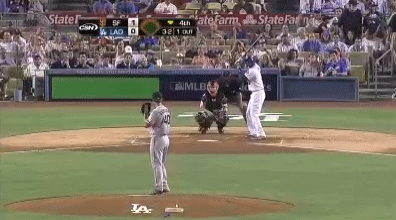
As if they were reciting lines from the same play, Bumgarner mimicked his counterpart's early-inning approach to a T, complete with seven fastballs and a pair of sliders among his nine first-pitch offerings. He threw first-pitch fastballs to the first five batters he faced, four of which were aimed on the outside edge to opposing right-handed hitters. Bumgarner threw a bevy of first-pitch sliders on his third trip through the batting order, locating them near the bottom of the zone in an attempt to induce groundballs early in the count, and at one point he started four consecutive hitters with a slider on the first pitch. He also tossed a handful of changeups on the day, three of which were thrown on the first pitch of an AB in order to catch hitters off guard.
Key AB: A.J. Ellis, bottom of the second inning.
The only sign of trouble for Bumgarner came in the second. He had plunked Juan Rivera before giving up a base hit to Luis Cruz, leaving two on for A.J. Ellis with two outs on the board. Up to this point, Bumgarner had thrown first-pitch fastballs to six of the seven hitters he’d faced, with the lone exception being the slider that struck Rivera two batters earlier, so one can imagine what was going through Ellis' head when Bumgarner's first-pitch slider traveled far inside on an over-rotated delivery.
Bumgarner queued up the slider again for the second pitch, this one following a path from hand to plate and getting the call on the outer half of the zone. The third offering was a fastball at 93 mph that missed up and away, followed by a 90-mph pitch with enough movement to induce a “cutter” label from Krukow and that triggered a big swing-and-miss from the Dodger catcher to even the count. Ellis fouled off another elevated fastball at 93 mph, setting the stage for the slider to re-emerge as Bumgarner targeted the inside corner at the bottom of the zone, leaving Ellis with no other option but a defensive swing that came up empty and sent him back to the dugout.
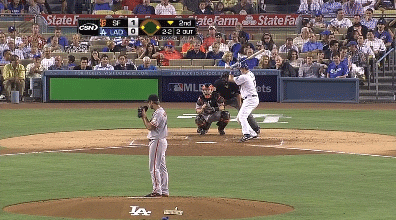
Mechanics Report Cards
Kershaw
|
Balance |
50 |
|
Momentum |
45 |
|
Torque |
60 |
|
Posture |
40 |
|
Release Distance |
45 |
|
Repetition |
65 |
Kershaw is a mechanical enigma. His herky-jerky motion features inconsistent balance and a pattern of linear momentum that has at least three different speeds. The lefty's mechanical funk includes decent early momentum that comes to a halt at max leg lift, at which point he drops the leg near the ground with little-to-no forward progress and a subtle pause, before a sudden burst of late momentum toward the plate as he glides the lead foot above the clay and settles into foot strike. The ridiculous complexity of his timing sequence helps to explain Kershaw's early-career struggles with pitch command, as even a veteran hurler would battle to find a consistent release point with such barriers to repetition.
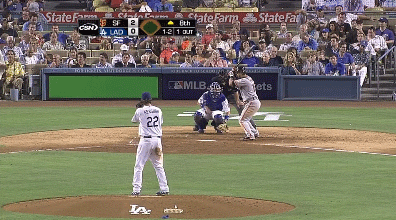
Combined with his relatively weak posture, these mechanical obstacles make it all the more impressive that Kershaw has been able to harness his delivery with such amazing repetition. His hip-heavy torque is well above average, including some additional upper-body load before rotation kicks in. These elements contribute to Kershaw's plus arm speed, but the rest of his mechanical profile is littered with inefficiency. The spine-tilt combines with the odd lift sequence to mute Kersh's distance at release point, once again teasing the realm of possibilities with respect to his ultimate ceiling. There is also a hitch in Kershaw's balance as he charges into foot strike, with a back-side collapse that causes the head to trail, but who can argue with a pitcher who consistently defies the odds with such success?
The delivery is more frustrating from the stretch, as Kershaw uses a slide step despite the advantages inherent for left-handers when holding runners. Aside from my usual slide-step rant, southpaws have a natural advantage in the game of chicken with opposing baserunners, since a pitcher that keeps his lift-knee in front of the rubber will be able to disguise his intent until he initiates the second gear of his momentum. A would-be thief has to delay the jump in order to protect against a pick-off move by a clever lefty, regardless of the height of leg lift, but Kershaw denies himself this opportunity by gliding toward the plate upon first movement. His back-up plan is a combination of pick-off moves, including a slow throw that he uses to lull runners to sleep and a snap-throw with the intent of generating outs. The Giants announcers have dubbed the latter technique the “Mulholland Move.”
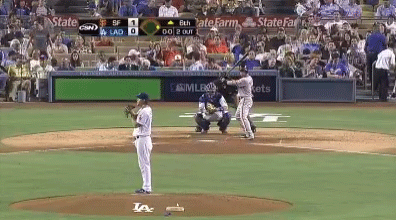
Kersh was doing everything in his power to beat the Giants, even participating in extracurricular activities with the bat and glove. He knocked base hits in each of his first two at-bats, only to be erased on a fielder's choice on each occasion. The highlight of the game came in the top of the third inning, when Kershaw's first pitch to a bunting Gregor Blanco produced a career-defining web gem that will go down as one of the greatest F-1's ever to be entered into a scorebook. The jaw-dropping play also meant that Kershaw would pitch the rest of the game with a dirty uniform, which can only be described as bad-ass.

Bumgarner
|
Balance |
60 |
|
Momentum |
45 |
|
Torque |
65 |
|
Posture |
80 |
|
Release Distance |
55 |
|
Repetition |
70 |
Bumgarner sets up on the third-base side of the rubber, a rather unique strategy considering the conventional coaching wisdom that left-handers should pitch from the left side in order to create angle. It is a critical distinction, as while the lefty/left-side rule might be apt for LOOGYs, the strategy falls apart for starting pitchers who are expected to face a plethora of right-handed bats (such as the seven righties that the Dodgers wrote on their lineup card on Monday). Bumgarner exemplifies this application with his exceptional ability to cover the inner half of the plate with pitches that cut in on the hands of right-handers. The blimp-cam offers an incredible viewpoint for evaluation, and the angle of the following clip makes it easy to see how Bumgarner's starting position on the rubber allows him to complete his stride on the centerline.
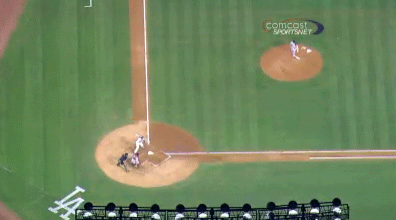
Another strategic advantage afforded by the blimp is a rare glimpse at hip-shoulder separation, otherwise known as the “torque” on Bumgarner's Mechanics Report Card. The overhead view allows us to isolate the hips as they open up into foot strike, while the shoulders prepare to fire with an enhanced upper-body load. Maximum torque occurs at the moment that trunk rotation kicks into gear, with a greater delay of rotation resulting in additional hip-shoulder separation. Bumgarner achieves awesome torque, though his velocity numbers are not quite what one would expect from such a high grade, leaving the door open for future velo gains if he can gain momentum and/or improve his functional strength.
Bumgarner’s delivery has a couple of identifying traits, from a low-three-quarters arm slot to pristine posture and even a corkscrew twist as he gets into max leg lift. The seemingly unusual signature helps to obscure the incredible efficiency of his mechanics, as the only blemish on Bumgarner's report card is below-average momentum that is puzzling given the left-hander's preference for the corkscrew strategy. A big leg kick aids his stride length, and absolutely ideal posture helps extend his release point to more than compensate for what he lacks in momentum.
Bumgarner has a weak pick-off move, though I prefer his method of avoiding the slide step from the stretch in order to preserve his natural leg kick and timing sequence. As mentioned with Kershaw, lefties have little to gain from a slide step, and a corkscrew pitcher like Bumgarner would require a major adjustment to find the timing pattern of a reduced leg kick. The San Francisco southpaw is better off trusting his delivery and his stuff to get him out of trouble, such as the strike-'em-out, throw-em-out double play that he and Posey busted out to end the fifth inning.
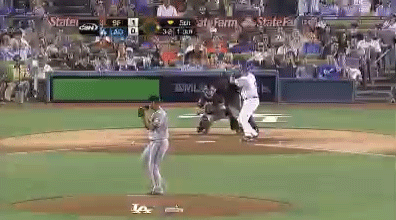
Thank you for reading
This is a free article. If you enjoyed it, consider subscribing to Baseball Prospectus. Subscriptions support ongoing public baseball research and analysis in an increasingly proprietary environment.
Subscribe now
Besides, I've been looking for an excuse to embed even more GIF's into an article.
Thanks!
Jim